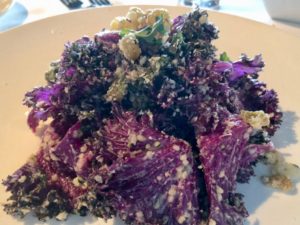The potential for drugs being derived from the plant, Cannabis sativa, marijuana, is being hampered by the United States Food and Drug Administration. Because marijuana is classified as a “schedule one” drug, it is nearly impossible to study the plant or its derivatives without onerous oversight – almost impossible to get. This, in spite of two drugs being approved from that plant, with potential for several more, and that it is completely legal to eat the seeds. In fact, you likely have eaten the seeds from that plant in your salad.
Hemp Seeds
In Culinary Medicine our focus is to provide information to our patients to optimize their health through their food. For example, we state that one to two glasses of wine a day is an optimal dose. We are always seeking out better foods and food groups to help our patients. One of those great foods are Hemp Seeds.

A fine Kale Salad with Hemp Seeds
Hemp seeds, which are really small nuts, have found their way onto many salads. Two tablespoons provide a about one third of the required protein, and a very high quality protein (made up of amino acids that our body cannot make so we rely on our diet to get them). The seeds are a great source of dietary fiber, vitamins, minerals, and essential fatty acids. The essential fatty acids found in this nut are “healthy fats” found to reduce heart disease and stroke (Callaway, JC 2004).
But because of the regulations over 90 per cent of the hemp seeds in the United States are imported from China. Why? Why, when this plant – literally grows like weed, can be sustainably harvested in the United States? The reason, because it is illegal to grow Cannabis sativa since it is listed as a schedule one drug. Don’t you think local grown seeds would be better?
Two FDA Drugs
From this seed, or nut, grows a plant that has been the origin of two FDA approved drugs.The recent drug approved by the FDA, called Epidiolex is exceedingly effective for two forms of childhood epilepsy, that until now have been horribly difficult to control. The other drug, Marinol, is used to improve the appetite of people with advanced cancer and HIV.
The Potential For More Medications
Over half of the medications found in your local pharmacy came from the foods we eat or the herbs we use to flavor them. Every year major drug companies go to the four corners of the world to investigate potential new drugs. They hire ethnobiologists to ask aboriginal peoples about traditional foods and medicines and what were used for various illness. From those have come drugs, such as Taxol, from the Pacific Yew Tree, used for ovarian cancer. Ironically, we have good evidence that from this plant there might be more drugs.
Good evidence has shown potential for other uses for drugs from this plant: good evidence for use for people with chronic pain – freeing them from opioids. Another use has been for people who have muscle spasticity from multiple sclerosis or para and quadriplegia – allowing them to have more control over their limbs. The most widely used in the world is its effect to decrease nausea and vomiting following chemotherapy.
Did you know that in states that have legalized medical marijuana there is a lower incidence of opioid addiction?
What Is This Issue
As a physician I hold a license to prescribe drugs from the Drug Enforcement Administration. But that license is for drugs from schedule 2 to schedule 5. Schedule 1 drugs are the drugs that are considered to have “no medical qualities” and are highly addictive. They include heroin, ecstasy, LSD, GHB (the date rape drug), mescaline, Peyote and other psychedelic mushroom derivatives (psilocybin and psilocin). But also on that list is marijuana and its derivatives. As with most physicians, I don’t ask for permission to prescribe schedule one because it is denied routinely.
The fact is, marijuana does not belong in schedule one. Because the other problem with schedule one drugs – it is difficult to research these drugs with federal grants. Recently the DEA has sped up the process to research these drugs, and there are over 500 research projects currently going on. The bottom line- if marijuana was a schedule 2 drug (this schedule includes vicodin, cocaine, methamphetamine) or schedule 3 (tylenol with codeine) it would be easier to study the drugs, isolate the chemical compounds, and test them for safety and efficacy).
Free The Weed
We need the FDA to place marijuana in a schedule that will allow US researchers to study the derivatives of this plant, and to sell the seeds for restaurants (don’t you want local grown hemp seeds?).
The Two Components of the Marijuana Plant
The components of the plant are cannabinoids, which are extracted by heating the plant’s flower and extracting the components in oil. The common forms are Δ9-tetrahydrocannabinol, or Δ9-THC, and cannabidiol, or CBD. The Δ9-THC, we will call it THC, is considered to be the major psychoactive ingredient forming the “high” (Gaoni & Mechoulam, 1964), the plant contains this chemical primarily in its non-psychoactive acid form, Δ9-tetrahydrocannabinolic acid (THCA), which is how you can enjoy the hemp seeds on the salad and not become high. To convert THCA into Δ9-THC. Once Δ9-THC, you need heat. The other component are the Cannabinoid-infused oil, which may also be purchased from dispensaries and retail shops.
Edibles, in the form of gummy bears, cookies, candy, have become popular, as opposed to smoking, and has been tracked in states where cannabis has been legalized for recreational or medicinal purposes. In 2014 Colorado noted 1.96 million units of edible medicinal cannabis-infused products and 2.85 million units of edible retail cannabis-infused products were sold. Those forms were about 45 percent of the total cannabis sales in the state (Brohl, Kammerzell, & Koski, 2015)
Cannabinoid-infused oil or cannabis used to make homemade edibles is not tracked as an edibles purchase, which means edible use is widely underestimated. Preference for edibles include that they are less conspicuous, not leaving a lingering odor, and some have reported that the “high” is calmer and more controlled (this has not been verified by science). Some individuals also feel that smoking cannabis has led to asthmatic attacks, long-term lung damage, and irritation. Edibles have been inadvertently ingested by infants, children, and unsuspecting adults sometimes leading to medical issues.
 Vaping cannabinoids is rising in popularity. The lungs provide a rapid absorption of the drug into the bloodstream and across the blood brain barrier. The advantage is this delivery mechanism is faster than an edible. Not only are the THC able to be delivered, but there are CBD “only” preparations that can be vaporized and inhaled.
Vaping cannabinoids is rising in popularity. The lungs provide a rapid absorption of the drug into the bloodstream and across the blood brain barrier. The advantage is this delivery mechanism is faster than an edible. Not only are the THC able to be delivered, but there are CBD “only” preparations that can be vaporized and inhaled.
There has been research, most often done in Europe and Canada, based on the wide number of anecdotal testimony. The best research has for muscle spasm and chronic pain (Borgelt, Franson, Nussbaum, & Wang, 2013; Harrison, Heritier, Childs, Bostwick, & Dziadzko, 2015 and Bellnier T, Brown GW, Ortega TR, 2018 ), nausea and vomiting (Smith, Azariah, Lavender, Stoner, & Bettiol, 2015), epilepsy (Friedman & Devinsky, 2015 and Brooke, K. et al 2017), appetite stimulation (Gorter, 1999), cancer (Pacher, 2013), including post-traumatic stress disorder, anxiety, depression; Betthauser, Pilz, & Vollmer, 2015; Zlebnik & Cheer, 2016).
The evidence supporting cannabinoid treatment for spasticity and chronic pain has been moderate, and in spite of an overwhelming group of cancer patients proclaiming medical marijuana for nausea and vomiting, that evidence is not great. Anecdotes do not make evidence. Marinol for appetite and weight gain in patients with HIV/AIDS or cancer, is approved, but sadly the efficacy for this drug is not as adequate as we would like it (Whiting et al., 2015).
Still, evidence for efficacy of cannabinoids rises to the level of where the FDA would approve further studies for toxicity, dosage, efficacy, and safety of these compounds, if they were not cannabis. Since cannabis is classified as a schedule one drug, it is unlikely such studies will occur in the United States. We need to free the weed.
The latest drug for epilepsy, Epidiolex, was approved by the FDA (see press here) and this may force the FDA to change the schedule of marijuana. In opposition to this is the Department of Justice under the Trump administration which has voiced opposition to reclassification of the marijuana out of schedule one. Oddly, President Trump has stated he would likely approve this change. We need to free the weed.
Because a number of states have approved the drug for medicinal use, there has been an increase in research funding from non-governmental sources. Most of that funding from the growers and distributors of cannabis products, and the veracity of such research is viewed with the same skepticism as pharmaceutical companies funding research of their own drugs.
Every drug has an ineffective range, hopefully an effective dose, and a toxic dose. Cannabis and its byproducts are no exception. We know from the studies of Epidiolex on epilepsy that ten per cent of the users had increased liver function tests, suggesting liver damage and that 2 percent of the patients were taken off the drug because of concern that the drug might lead to permanent liver damage (Szalfarski et. al 2018). While most local cannabis shops will tell you there are no side effects to these drugs or oils, they are duplicitous, misleading, or uninformed. It is unlikely that the local dispensary of medical marijuana will have the subjects tested for such side effects, which could potentially result in disaster.
In our podcast, THC expert and enthusiast Evo Terra, calls many medical marijuana advocates to task for being more interested in getting high than determining efficacy for various conditions.
THC is not without its own side effects (Koby Cohen and Aviv M. Weinstein). There are up to ten per cent who cannot tolerate the “high” and causes them to have reactions from psychosis, paranoia, and dysphoria (all apparently reversible). Often bad side effects are noted among naive users, or those individuals who accidentally inject edibles. This has been noted more among senior citizens, which may occur because those are the individuals likely to have cancer.
Contrary to what many think – cannabis has been associated with deaths. There have been cardiac deaths from the drug. There have also been an increase in admissions to emergency rooms for synthetic and non-synthetic marijuana. In a six month collection of data there were 2198 presentations to the ER in ten EU countries, and one death from an 18 year old who died from a cardiac arrest (no other drugs were found in the blood test). For that report click here.
While this plant has some known toxicity, there is a clear promise that some new medications can come from it. Of the many variations of the oils from this plant, the ability to purify them and modify them will allow determination of ranges of efficacy, toxicity, and ineffective doses.
Disclaimer: I have never ingested or smoked, recreational or medicinal marijuana. However, since the podcast was produced I did enjoy some hemp seeds on a kale salad. I am on record as being in favor of not only changing the schedule for marijuana, but to legalize recreational marijuana as well as medical marijuana. However, should studies show that this drug might be best placed under schedule for DEA then I would clearly be in favor of that.
